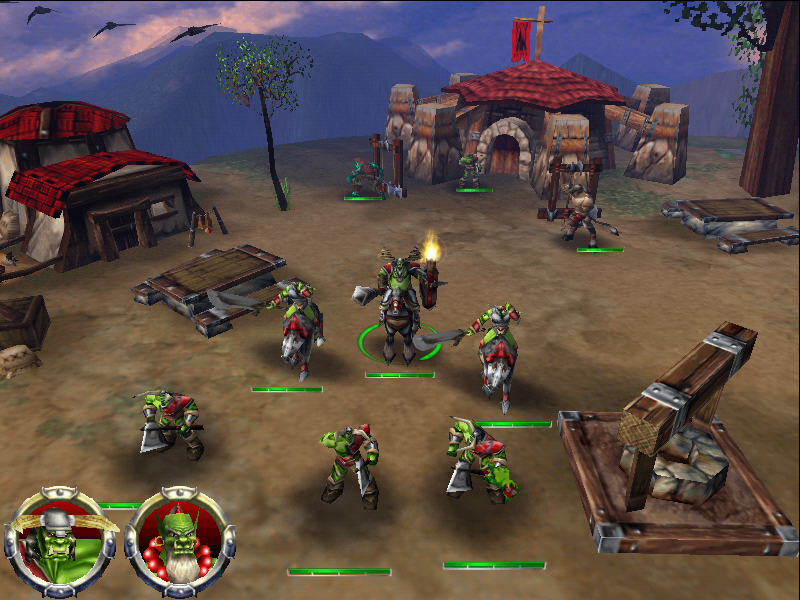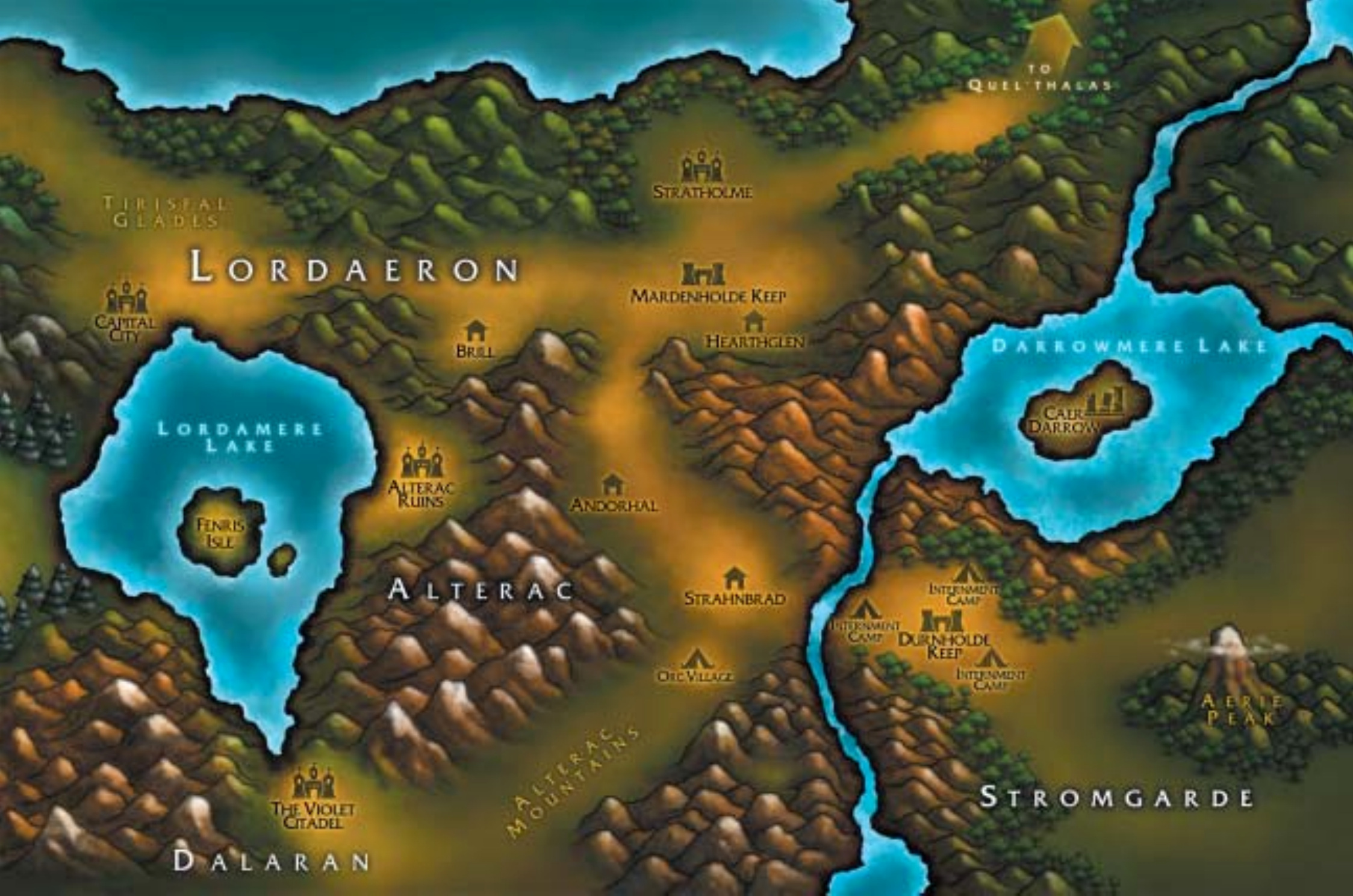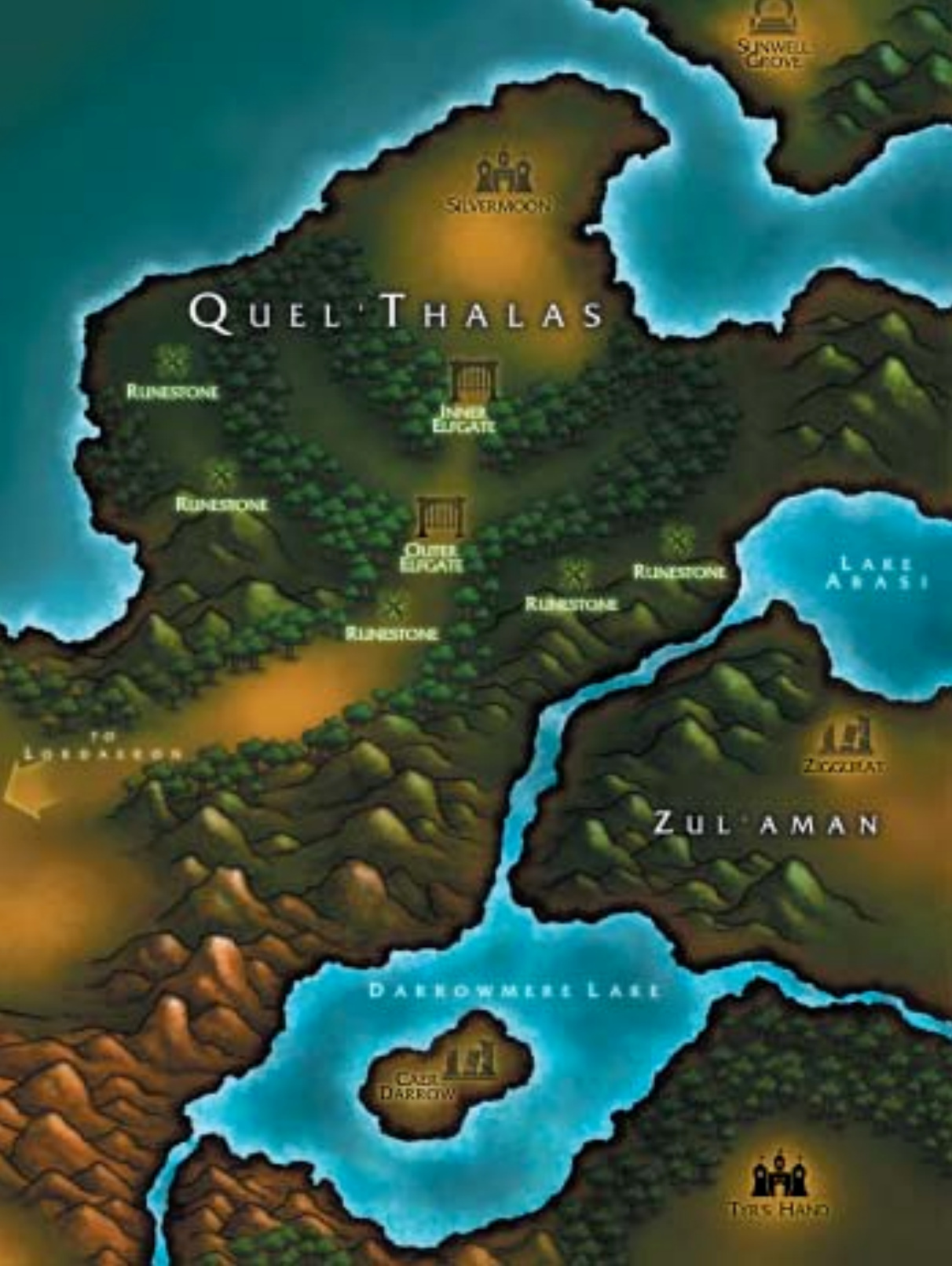Warcraft Retrospective 17: Reign of Chaos Manual, Red and Blue

And so we get to Warcraft 3.
It’s hard to overstate just how much influence this game had on the Warcraft franchise. It expanded the universe and the scope of its mythos like no other Warcraft work before or after it, established the overall geography of the world of Azeroth, and set up important themes that would continue to be followed by later works, with varying success. It codified what we now think of as “the Warcraft aesthetic”. We look at Warcraft 1 and 2 and blink at the mix of alien aesthetics and familiar names. We look at Warcraft 3 and immediately recognize it as Warcraft.
Warcraft 3 gave us a plethora of memorable lore moments whose repercussions are still referenced by Blizzard and roleplayed today, like the Culling of Stratholme, the siege of Silvermoon, and the Battle of Mount Hyjal. It introduced iconic characters like Thrall1, Arthas, Jaina, Sylvanas, Kel’Thuzad, Tyrande, Malfurion2, Illidan, Maiev, Kael’thas… The list goes on. No Warcraft game, before or since, has introduced this many fan-beloved characters, all at once.
And, of course, in addition to the Alliance and the Horde as we knew them from the previous games, this game introduced three new sides into the conflicts that shake Azeroth: the undead Scourge and the demonic Burning Legion, both of which would become beloved and remembered recurring antagonists of some of the most critically acclaimed WoW expansions, and the night elves, who even now are one of the most lore-rich, fan-beloved, and most played races in WoW.
Vanilla World of Warcraft may have codified the detailed geography of the world, but it was Warcraft 3 that made the world as we know it.
Let’s dive in.
Development of Warcraft 3
The first thing to notice is that the gap between Beyond the Dark Portal and vanilla Warcraft 3, subtitled Reign of Chaos, is by far the longest gap between any two Warcraft games, ever. Beyond the Dark Portal came out in 1996, but Reign of Chaos didn’t materialize until 2002. That’s six years. What happened?
Well… Warcraft Wiki has an excellent writeup. I’ll go through the gist.
Part of the reason is that the gap was supposed to be bridged by Warcraft Adventures, which was canceled. Then Blizzard began development of another game, called Warcraft Legends, which would see the player control a single hero through an over-the-shoulder camera. That one was also canceled. Then they started with another game called Heroes of Warcraft, which would have been an instanced, squad-based tactical combat game. That game was also canceled. But the fourth one stayed up.
Even then, the Warcraft 3 that was announced was not the one we got.

The early preview from 1999 talked about Warcraft 3 as a “role-playing strategy” game, essentially an RPG in a big seamless world, still with the concept of the camera following a hero and their squad, exploring the world, talking to NPCs, and having RTS-style squad battles. It was supposed to have six playable races — with the humans, orcs and demons announced as playable — and to come out in late 2000. Other than some unit designs, models, and cinematics, all of this was essentially scrapped.
The Warcraft 3 we did eventually get was a more traditional, if very innovative, real-time strategy. It integrated some of the design decisions from Starcraft, such as featuring unique gameplay for each side instead of them being reskins of each other, and a single narrative that went through each side in turn to tell one big overarching story. However, there was one important element that carried over from the original concept of Warcraft 3: the idea of unit stacks led by heroes. It directly influenced much of the rest of the game’s design.
Details kept changing throughout development. The game could have had as few resources as one (gold) or as many as three (oil and naval units were discussed, but eventually discarded). The planned number of playable factions was somewhere between six and thirteen, but was scaled down to four. The Burning Legion was supposed to be a playable faction, and was even announced as one, but was changed into an antagonist-only faction when Blizzard realized that having them gather gold and construct farms undermined the threat they represented.
Instead, we got the night elves. Blizzard didn’t want to introduce classic D&D-style elves as a separate faction, so one developer suggested adding dark elves instead. However, the team didn’t want D&D-style drow either, so they combined the wood elf and dark elf concepts into one race… and got something very distinct, original, and without precedent in fantasy games.
Oh, and the pandaren, another iconic Warcraft race, began as an April Fools joke that announced them as a Warcraft 3 faction. It all began with this image, drawn for fun by artist Samwise Didier, and the April Fool announcement generated enough genuine excitement that Blizzard just said “throw it in” and actually put some pandaren in the expansion. We’ll get there.
Warcraft 3 was also Blizzard’s first 3D game, developed with an in-house engine. Everything was new and the technology was untested. Countless art assets and models were made, scrapped, and remade until the team got the look just right. This was the time of Classic Blizzard, when long development times meant quality.

In 1999, three years before the game’s eventual release, the Warcraft 3 engine was forked to explore all those RPG ideas that got cut out of Warcraft 3 itself when the project was retooled into a more traditional RTS. And that resulted in… well…
All in due time.
The Manual (Half of It)
In July 2002, the game finally hit the shelves, and for the first time in my life, I was there for it. As usual, I’ll start with the manual.
Because of the sheer wealth of new content, I’ve split this post in two. For today, I’ll focus on the two factions we already know from the previous games: the human Alliance and the orcish Horde.
The Humans

In a departure from Warcraft 1 and 2, the Warcraft 3 manual uses omniscient narration, not in-universe unreliable narrators.
We start with a recap what we already know, from the end of Tides of Darkness onwards, but with some details changed.
- The orcs’ siege of Lordaeron was broken, and the Horde retreated south, all the way to Blackrock Spire, where Lord Lothar was slain — not in an ambush, but in a duel with Orgrim Doomhammer himself. His lieutenant Turalyon then picked up his shield, brought Orgrim down and chased the Horde back to the Dark Portal, the land around which was now a wasteland called the Blasted Lands. We’re only one page in and I already count three retcons for Tides of Darkness, including retconning a Beyond the Dark Portal character into its events!
- Ner’zhul reopened the Dark Portal, stole a number of magical artifacts, and the Alliance Expedition counterattacked, culminating in Draenor’s catastrophic explosion. So far so good.
- The remaining orcs were carried into internment camps, but the Dragonmaw clan held out in Khaz Modan until the mage Rhonin and his allies infiltrated Grim Batol and freed the dragon queen Alexstrasza–
…Wait, what?
Why did they retcon the events of Day of the Dragon into taking place after Beyond the Dark Portal? This makes no sense no matter how you cut it, as the obvious intended point of that novel was to explain how the Horde lost Alexstrasza’s dragons after Tides of Darkness, why they had to turn to Deathwing for replacements in Beyond the Dark Portal, and why Deathwing sought refuge on Draenor. And how he got all those eggs, for that matter.
In the revised timeline, Deathwing’s personal story becomes very, very convoluted. It means that he approached Ner’zhul’s Horde after the Dark Portal was reestabished, flew to Draenor, somehow survived being killed by the Alliance Expedition (outright retconning the human mission where he dies), flew back to Azeroth, meddled with Rhonin’s quest to free Alexstrasza, faced the wrath of the four re-empowered Dragon Aspects, and then bravely spread his wings and fled… somewhere.
Did the writers of the Reigns of Chaos manual even read the bloody book?
- The Alliance splintered, with Quel’Thalas, Gilneas and Stromgarde seceding. The other nations, including the restored Kingdom of Azeroth ruled by young king Varian Wrynn, reaffirmed their commitment to King Terenas of Lordaeron and to the Alliance.
- Peace settled in Lordaeron, and a new generation came of age. Young Prince Arthas, son of King Terenas, was inducted into the Order of the Silver Hand as a paladin under the tutelage of Uther the Lightbringer. He was headstrong and somewhat arrogant, but displayed bravery and heroism, distinguishing himself in defense of Quel’Thalas from the troll warbands of Zul’Aman.
- Meanwhile, Jaina Proudmoore, the young daughter of the Lord Admiral of Kul Tiras, excelled in her magic studies in Dalaran under Archmage Antonidas. Arthas and Jaina had a brief romantic relationship, but were separated by their respective callings, as Jaina felt her calling was the pursuit of knowledge, not the throne room.
- After nearly thirteen years of peace, the orcs escaped the internment camps and reformed the Horde, evading capture for now. To make things worse, rumors of “death cults” promising their members eternal life spread across Lordaeron. This is where our story begins…

As usual, we have a section on units. It’s pretty utilitarian this time, without as much flavor lore as in Warcraft 1. We have three hero units: the archmage, a mounted caster that can summon blizzards, water elementals, and teleport armies; the mountain king, a mighty dwarven warrior who can throw his hammer, stomp on the ground and transform into an empowered Avatar state3; and the paladin, who can heal allies, become invulnerable, and mass-resurrect.
The peasant, footman, knight, flying machine (now called a gyrocopter, a dwarven redesign of gnomish tech), and gryphon rider all make a reappearance. Notably, peasants can now be called to arms from the town hall, and turn into militia for the short time. Footmen can now assume defensive stance for better protection from piercing attacks, at the cost of slower movement speed.
The new arrivals come not from humans, but from allied races. The dwarves have contributed the rifleman, the new ranged unit that replaces the elven archer, and the first unit to use firearms in Warcraft. The dwarves also have the mortar team, a glass-cannon ranged siege unit, and the steam tank, a sturdy melee siege machine. The elves introduce the priest, a support caster who can buff allies, heal over time and dispel, and the sorceress, who can slow enemy attacks, turn invisible, or polymorph enemies into sheep. Unlike Warcraft 2, the Polymorph spell here is not permanent.
The Orcs

The orc manual doesn’t really tell us anything we don’t already know from the previous games and books.
- During the Second War, the Horde, led by Orgrim Doomhammer, reached the capital city of Lordaeron (creatively called Capital City) and almost breached it, but the betrayal of Gul’dan, who left for the Tomb of Sargeras in a critical moment, allowed the Alliance to regroup and push the orcs back south.
- With the Dark Portal destroyed, elder shaman Ner’zhul gathered what was left of the Horde back on Draenor, reopened the Dark Portal, and stole artifacts from Azeroth to open portals to new worlds. However, he miscalculated, and the tremendous energies from the new portals tore Draenor apart. Ner’zhul and his followers barely escaped through the portals, but Grom Hellscream and Kilrogg Deadeye, and their clans, hacked their way through the human defenders of the Dark Portal back to Azeroth (in a departure from the game, where they were intentionally abandoned on Azeroth by Ner’zhul instead).
- Nekros Skullcrusher, the warlock of the Dragonmaw clan, tried to reunite the Horde with an army of dragons, but his plans were foiled by an Alliance team led by Rhonin. The placement of this event in the timeline still makes no sense.
- The captured orcs were settled in internment camps in Lordaeron and soon succumbed to a strange lethargy. Though some speculated it was caused by a disease, Archmage Antonidas instead theorized that it was a result of withdrawal from demonic magic. He was, however, unable to find a cure.
- Thrall, son of Durotan, escaped his confinement in Durnholde Keep, where he was raised in infancy by the human lord Aedelas Blackmoore. He reunited with Grom Hellscream and the Frostwolf clan, once led by his father, discovered the orcs’ shamanistic past, and led the reunited Horde against the internment camps and Durnholde Keep itself. During one of the sieges, Orgrim Doomhammer fell in battle, and Thrall picked up his armor and hammer, succeeding him as Warchief.
The orc heroes are the blademaster, a fast and stealthy melee fighter; the far seer, a wolf-riding spellcaster with elemental magic and the power to summon spirit wolves; and a spoiler hero that we’ll talk about later, during the campaign.
The roster of the Horde has changed, too. The peons and grunts are naturally back. Notably, the ogres and goblins are all gone, as are all the high-tech units; the only mechanical unit the orcs now have is the good old catapult. The raiders are back, with no lore explanation — unlike their absence in Warcraft 2. They’re just there. All the dark magic, be it warlocks, necrolytes or death knights, is gone as well. Instead, the orcs now have a new caster unit, the shaman, with the very iconic Bloodlust spell that carried over from Warcraft 2’s ogre-mage.
This is not to say that this new Horde consists of just orcs. It is said that Thrall has befriended a tribe of jungle trolls from Stranglethorn. Their units are the headhunter, a ranged attacker replacing the forest troll axethrower from Warcraft 2, and the witch doctor, a caster capable of placing healing wards for health regeneration and sentry wards for scouting.
The third race of the new Horde is a campaign spoiler, and we’ll talk about it later, during the playthrough.

What’s Next?
For Warcraft 3, I’m going to switch to shorter posts twice per week instead of making one mega-post once per week. Tomorrow, I’ll go through the rest of the Reign of Chaos manual, which deals with the newcomers to the setting: undead, night elves, and the Burning Legion.
And starting next week, I’ll be going through Reign of Chaos itself, starting with the prologue campaign. And not just the two missions in the retail release, but all five.
-
Technically, Thrall was introduced in Lord of the Clans, but it’s far, far more obscure than Warcraft 3 is. For most people who aren’t lore nerds, Warcraft 3 was his first appearance. ↩
-
Called Furion in Reign of Chaos. We’ll get to that. ↩
-
Not the Avatar State. ↩
Leave a Comment